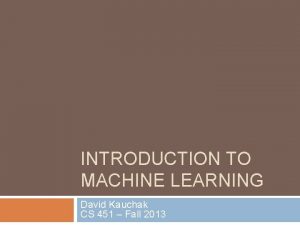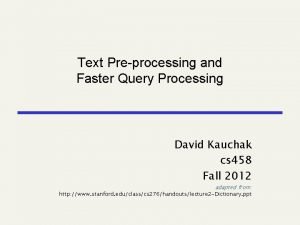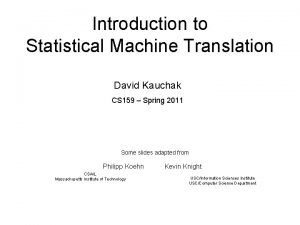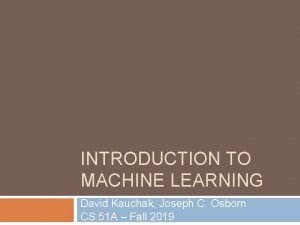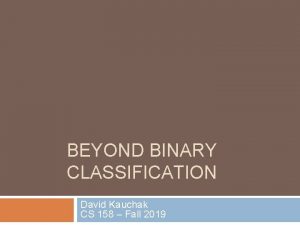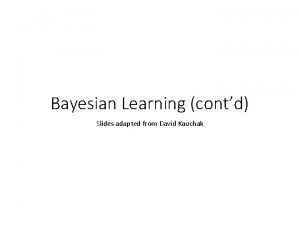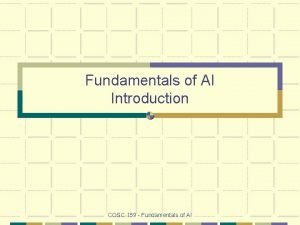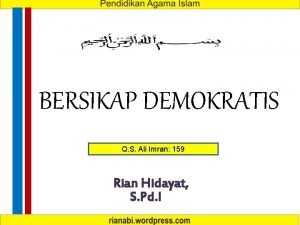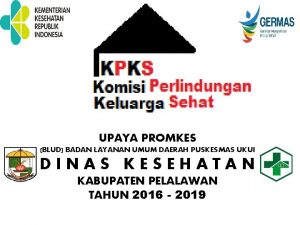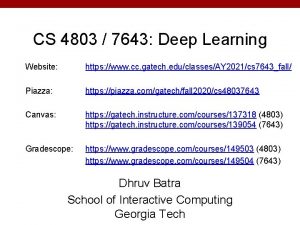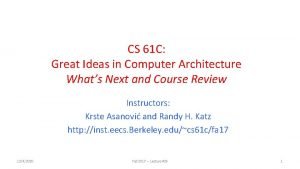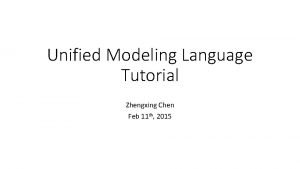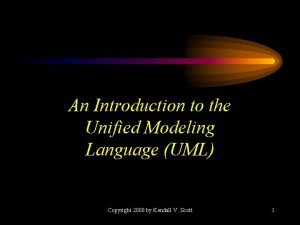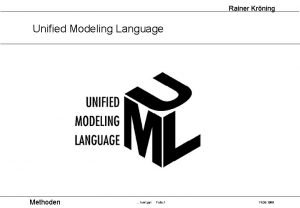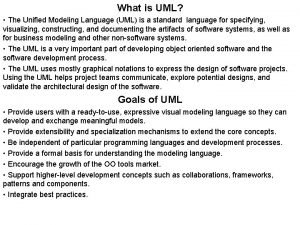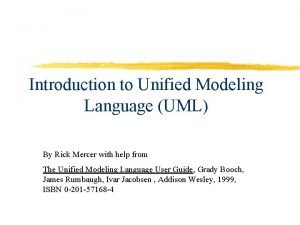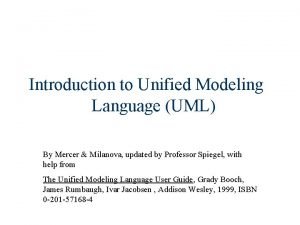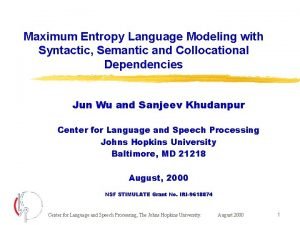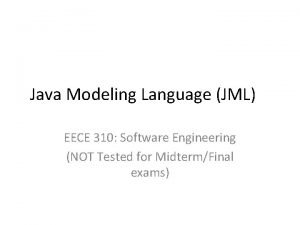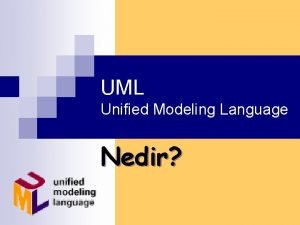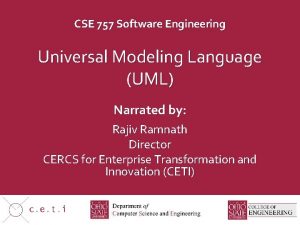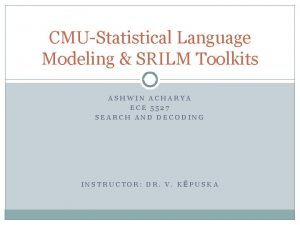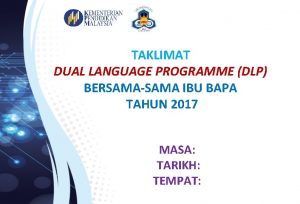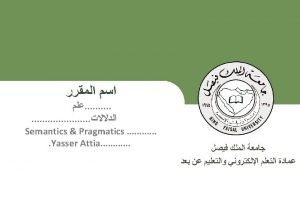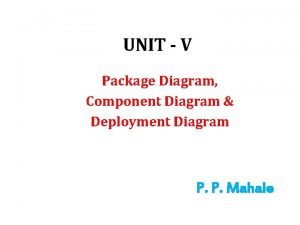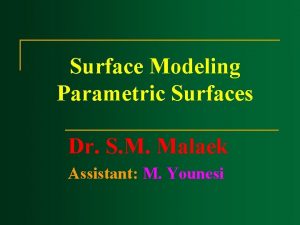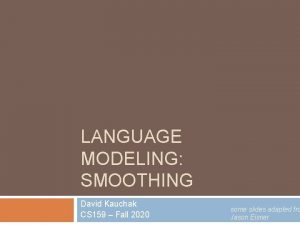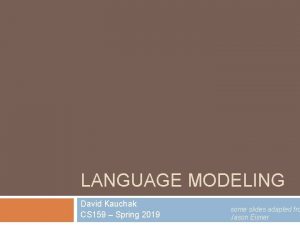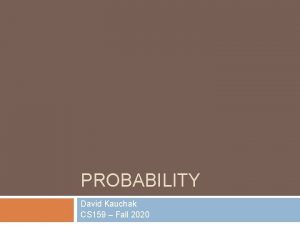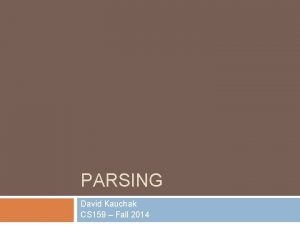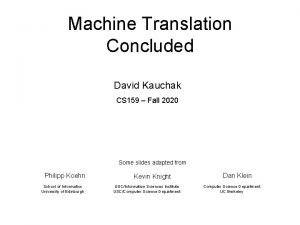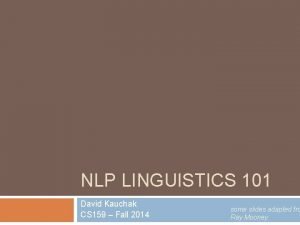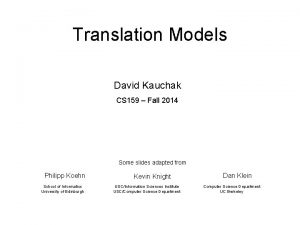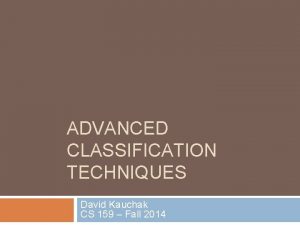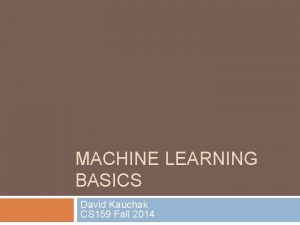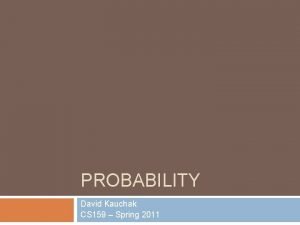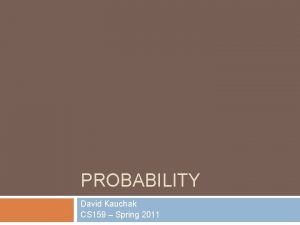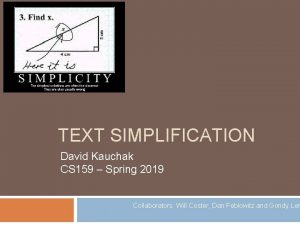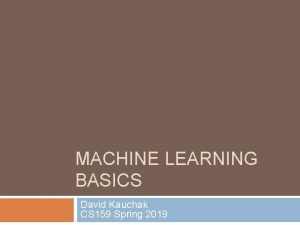LANGUAGE MODELING David Kauchak CS 159 Fall 2020
























































- Slides: 56

LANGUAGE MODELING David Kauchak CS 159 – Fall 2020 some slides adapted fro Jason Eisner

Admin How did assignment 1 finish up? Assignment 2 out soon (two part assignment) Class participation Videos!

Independence Two variables are independent if they do not affect each other For two independent variables, knowing the value of one does not change the probability distribution of the other variable � the result of the toss of a coin is independent of a roll of a dice � price of tea in England is independent of the whether or not you get an A in NLP

Independent or Dependent? You catching a cold and a butterfly flapping its wings in Africa Miles per gallon and driving habits Height and longevity of life

Independent variables How does independence affect our probability equations/properties? If A and B are independent, written � � P(A|B) = P(A) P(B|A) = P(B) What does that mean about P(A, B)?

Independent variables How does independence affect our probability equations/properties? If A and B are independent, written � � P(A|B) = P(A) P(B|A) = P(B) P(A, B) = P(A|B) P(B) = P(A) P(B) P(A, B) = P(B|A) P(A) = P(A) P(B)

Conditional Independence Dependent events can become independent given certain other events Examples, � height and length of life � “correlation” studies size of your lawn and length of life http: //xkcd. com/552/

Conditional Independence Dependent events can become independent given certain other events Examples, � height and length of life � “correlation” studies size of your lawn and length of life If A, B are conditionally independent given C � P(A, B|C) = P(A|C) P(B|C) � P(A|B, C) = P(A|C) � P(B|A, C) = P(B|C) � but P(A, B) ≠ P(A)P(B)

Assume independence Sometimes we will assume two variables are independent (or conditionally independent) even though they’re not Why? � Creates a simpler model p(X, Y) many more variables than just P(X) and P(Y) � May not be able to estimate the more complicated model

Language modeling What does natural language look like? More specifically in NLP, probabilistic model p( sentence ) p(“I like to eat pizza”) p(“pizza like I eat”) Often is posed as: p( word | previous words ) p(“pizza” | “I like to eat” ) p(“garbage” | “I like to eat”) p(“run” | “I like to eat”)

Language modeling How might these models be useful? � Language generation tasks machine translation summarization simplification speech recognition … � Text correction spelling correction grammar correction

Ideas? p(“I like to eat pizza”) p(“pizza like I eat”) p(“pizza” | “I like to eat” ) p(“garbage” | “I like to eat”) p(“run” | “I like to eat”)

Look at a corpus

Language modeling I think today is a good day to be me Language modeling is about dealing with data sparsity!

Probabilistic Language modeling A probabilistic explanation of how the sentence was generated Key idea: � break this generation process into smaller steps � estimate the probabilities of these smaller steps � the overall probability is the combined product of the steps

Language modeling Many approaches: � n-gram language modeling Start at the beginning of the sentence Generate one word at a time based on the previous words � syntax-based language modeling Construct the syntactic tree from the top down e. g. context free grammar eventually at the leaves, generate the words Pros/cons?

n-gram language modeling I think today is a good day to be me

Our friend the chain rule Step 1: decompose the probability P(I think today is a good day to be me) = P(I | <start> ) x P(think | I) x P(today| I think) x P(is| I think today) x P(a| I think today is) x P(good| I think today is a) x … How can we simplify these?

The n-gram approximation Assume each word depends only on the previous n-1 words (e. g. trigram: three words total) P(is| I think today) ≈ P(is|think today) P(a| I think today is) ≈ P(a| today is) P(good| I think today is a) ≈ P(good| is a)

Estimating probabilities How do we find probabilities? P(is|think today) Get real text, and start counting (MLE)! P(is|think today) = count(think today is) count(think today)

Estimating from a corpus Corpus of sentences (e. g. gigaword corpus) n-gram language model ? …

Estimating from a corpus I am a happy Pomona College student. count all of the trigrams <start> I am a happy Pomona College student. <end> why do we need <start> and <end>?

Estimating from a corpus I am a happy Pomona College student. count all of the trigrams <start> I am a happy Pomona College student. <end> Do we need to count anything else?

Estimating from a corpus I am a happy Pomona College student. count all of the bigrams <start> I I am am a a happy Pomona College student. . <end> p(c|a b) = count(a b c) count(a b)

Estimating from a corpus 1. Go through all sentences and count trigrams and bigrams � usually you store these in some kind of data structure 2. Now, go through all of the trigrams and use the count and the bigram count to calculate MLE probabilities � do we need to worry about divide by zero?

Applying a model Given a new sentence, we can apply the model p( Pomona College students are the best. ) = ? p(Pomona | <start> ) * p( College| <start> Pomona ) * p( students | Pomona College ) * … p( <end>|. <end>) *

Generating examples We can also use a trained model to generate a random sentence Ideas? <start> We have a distributio n over all possible starting words p( Apples | <start> ) p( I | <start> ) p( The| <start> ) … Draw one from this distributio p( A | <start> ) p( Zebras| <start> )

Generating examples <start> Zebras repeat! p( are | <start> Zebras) p( eat | <start> Zebras ) p( think | <start> Zebras ) p( and| <start> Zebras ) … p( mostly| <start> Zebras )

Generation examples Unigram are were that ères mammal naturally built describes jazz territory heteromyids film tenor prime live founding must on was feet negro legal gate in on beside. provincial san ; stephenson simply spaces stretched performance double-entry grove replacing station across to burma. repairing ères capital about double reached omnibus el time believed what hotels parameter jurisprudence words syndrome to ères profanity is administrators ères offices hilarius institutionalized remains writer royalty dennis , ères tyson , and objective , instructions seem timekeeper has ères valley ères " magnitudes for love on ères from allakaket , , ana central enlightened. to , ères is belongs fame they the corrected , . on in pressure %NUMBER% her flavored ères derogatory is won metcard indirectly of crop duty learn northbound ères dancing similarity ères named ères berkeley. . off-scale overtime. each mansfield stripes dānu traffic ossetic and at alpha popularity town

Generation examples Bigrams the wikipedia county , mexico. maurice ravel. it is require that is sparta , where functions. most widely admired. halogens chamiali cast jason against test site.

Generation examples Trigrams is widespread in north africa in june %NUMBER% units were built by with. jewish video spiritual are considered ircd , this season was an extratropical cyclone. the british railways ' s strong and a spot.

Evaluation We can train a language model on some data How can we tell how well we’re doing? � for example bigrams vs. trigrams 100 K sentence corpus vs. 100 M …

Evaluation A very good option: extrinsic evaluation If you’re going to be using it for machine translation � � build a system with each language model compare the two based on their approach for machine translation Sometimes we don’t know the application Can be time consuming Granularity of results

Evaluation Common NLP/machine learning/AI approach Training sentences All sentences Testing sentences

Evaluation Test sentences n-gram language model Ideas?

Evaluation A good model should do a good job of predicting actual sentences Test sentences model 1 probability compar e model 2 probability

Evaluation Pros: Fine for comparing two models Cons: Doesn’t give us a sense of how well any model is doing Test sentences model 1 probability compar e model 2 probability

The problem Which of these sentences will have a higher probability based on a language model? I like to eat banana peels with peanut butter.

The problem Which of these sentences will have a higher probability based on a language model? I like to eat banana peels with peanut butter. Since probabilities are multiplicative (and between 0 and 1), they get smaller for longer sentences.

The solution: perplexity average the probabilities geometric mean

Calculating perplexity in practice What is this?

Calculating perplexity in practice Average logprob per word!

Calculating perplexity - This is often how it’s calculated (and how we’ll calculate it) - Avoid underflow from multiplying too many small probabilities together

Another view of perplexity Weighted average branching factor � number of possible next words that can follow a word or phrase � measure of the complexity/uncertainty of text (as viewed from the language models perspective)

Smoothing What if our test set contains the following sentence, but one of the trigrams never occurred in our training data? P(I think today is a good day to be me) = P(I | <start>) x P(think | <start> I) x P(today| I think) x P(is| think today) x P(a| today is) x P(good| is a) x … If any of these has never been seen before, prob = 0!

A better approach p(z | x y) = ? Suppose our training data includes … x y a. . … x y d … but never: xyz We would conclude p(a | x y) = 1/3? p(d | x y) = 2/3? p(z | x y) = 0/3? Is this ok? Intuitively, how should we fix these?

Smoothing the estimates Basic idea: p(a | x y) = 1/3? reduce p(d | x y) = 2/3? reduce p(z | x y) = 0/3? increase Discount the positive counts somewhat Reallocate that probability to the zeroes Remember, it needs to stay a probability distribution

Other situations p(z | x y) = ? Suppose our training data includes … x y a … (100 times) … x y d … (100 times) but never: x y z Suppose our training data includes … x y a … … x y d … … x y … (300 times) but never: x y z Is this the same situation as

Smoothing the estimates Should we conclude p(a | xy) = 1/3? p(d | xy) = 2/3? p(z | xy) = 0/3? reduce increase p(c|a b) = count(a b c) count(a b) Readjusting the estimate is particularly important if: � the denominator is small … 1/3 probably too high, 100/300 probably about right � numerator is small … 1/300 is probably too high, 100/300 probably about right

Add-one (Laplacian) smoothing xya xyb xyc xyd xye … xyz Total xy 1 0 0 2 0 1/3 0/3 2/3 0/3 2 1 1 3 1 2/29 1/29 3/29 1/29 0 3 0/3 3/3 1 29 1/29 29/29

Add-one (Laplacian) smoothing 300 observations instead of 3 – better data, less smoothing xya xyb xyc xyd xye … xyz 100/300 0 0/300 200/300 0 0/300 Total xy 300/300 0 0/300 101/326 1 1/326 201/326 1 1/326 326/326

Add-one (Laplacian) smoothing What happens if we’re now considering a vocabulary of 20, 000 words? xya xyb xyc xyd xye … xyz Total xy 1 0 0 2 0 1/3 0/3 2/3 0/3 2 1 1 3 1 2/29 1/29 3/29 1/29 0 3 0/3 3/3 1 29 1/29 29/29

Add-one (Laplacian) smoothing 20, 000 words, not 26 letters see the abacus 1 1/3 2 2/20003 see the abbot 0 0/3 1 1/20003 see the abduct 0 0/3 1 1/20003 see the above 2 2/3 3 3/20003 see the Abram 0 0/3 1 1/20003 see the zygote 0 0/3 1 1/20003 Total 3 3/3 20003/20003 … Any problem with this?

Add-one (Laplacian) smoothing An “unseen event” is a 0 -count event The probability of an unseen event is 19998/20003 � add one smoothing thinks it is very likely to see a novel event The problem with add-one smoothing is it gives too much probability mass to unseen events see the abacus 1 1/3 2 2/20003 see the abbot 0 0/3 1 1/20003 see the abduct 0 0/3 1 1/20003 see the above 2 2/3 3 3/20003 see the Abram 0 0/3 1 1/20003 see the zygote 0 0/3 1 1/20003 Total 3 3/3 20003/20003 …

see the abacus 1 1/3 see the abbot 0 see the abduct y ilit ab ob pr m n odif ica tio The general smoothing problem ? ? 0/3 ? ? 0 0/3 ? ? see the above 2 2/3 ? ? see the Abram 0 0/3 ? ? … see the zygote 0 0/3 ? ? Total 3 3/3 ? ?

Add-lambda smoothing A large dictionary makes novel events too probable. Instead of adding 1 to all counts, add = 0. 01? � This gives much less probability to novel events see the abacus 1 1/3 1. 01/203 see the abbot 0 0/3 0. 01/203 see the abduct 0 0/3 0. 01/203 see the above 2 2/3 2. 01/203 see the Abram 0 0/3 0. 01/203 0. 01/203 … see the zygote 0 0/3 0. 01 Total 3 3/3 203
 Cs 451
Cs 451 Lebensversicherungsgesellschaftsangestellter
Lebensversicherungsgesellschaftsangestellter David kauchak
David kauchak David kauchak
David kauchak David kauchak
David kauchak David kauchak
David kauchak David kauchak
David kauchak Introduction to teaching 6th edition
Introduction to teaching 6th edition Helen erickson nursing theory
Helen erickson nursing theory Relational modeling vs dimensional modeling
Relational modeling vs dimensional modeling Father of the sonnet
Father of the sonnet Ai 159
Ai 159 Iso/tc 159
Iso/tc 159 Page 159
Page 159 159 ap
159 ap Cs 159
Cs 159 Surah ali imran 159
Surah ali imran 159 Mokena school district calendar
Mokena school district calendar Infrastrukturmaster und globaler katalog
Infrastrukturmaster und globaler katalog Modul 159
Modul 159 P 159
P 159 Iso tc 159
Iso tc 159 Fas 105
Fas 105 Route 159
Route 159 Cs 7643 deep learning
Cs 7643 deep learning Cs 61
Cs 61 Cs61c fall 2020
Cs61c fall 2020 Virtual reality modeling language tutorial
Virtual reality modeling language tutorial Unified modeling language tutorial
Unified modeling language tutorial Omg systems modeling language
Omg systems modeling language Introduction to the unified modeling language
Introduction to the unified modeling language What does vrml stand for
What does vrml stand for Ppt uml
Ppt uml Pengertian unified modeling language
Pengertian unified modeling language What-is-uml
What-is-uml Universal modelling language
Universal modelling language Introduction to unified modeling language
Introduction to unified modeling language Mercer oneview login
Mercer oneview login Uniform modeling language
Uniform modeling language Language modeling incorporates rules of
Language modeling incorporates rules of Java modeling language
Java modeling language Uml diagram nasıl çizilir
Uml diagram nasıl çizilir Fungsi uml
Fungsi uml Object diagram captures the behavior of a single use case.
Object diagram captures the behavior of a single use case. Interaction overview diagram
Interaction overview diagram Language
Language Uml
Uml Ashwin acharya
Ashwin acharya Example of sound devices onomatopoeia
Example of sound devices onomatopoeia Senarai sekolah dual language program 2021
Senarai sekolah dual language program 2021 David crystal the cambridge encyclopedia of language
David crystal the cambridge encyclopedia of language Plasma simulation software
Plasma simulation software Common modeling techniques of deployment diagram
Common modeling techniques of deployment diagram Threat modelling web application
Threat modelling web application Parametric surface modeling
Parametric surface modeling Mhc-pms use case diagram
Mhc-pms use case diagram Simulation modeling and analysis law kelton
Simulation modeling and analysis law kelton
